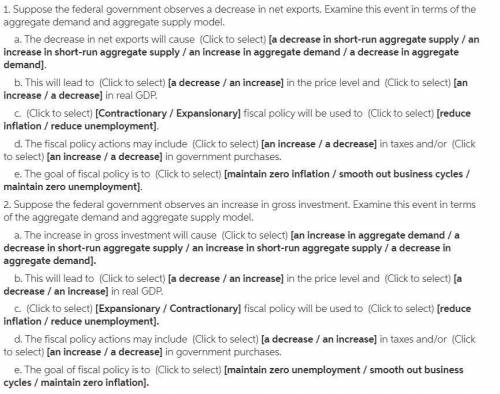
Business, 18.03.2021 01:20 puchie1225
1. Suppose the federal government observes a decrease in net exports. Examine this event in terms of the aggregate demand and aggregate supply model.
A. The increase in gross investment will cause.
B. This will lead toin the price level andin real GDP.
C. fiscal policy will be used to.
D. The fiscal policy actions may includein taxes and/orin government purchases.
E. The goal of fiscal policy is to.
2. Suppose the federal government observes an increase in gross investment. Examine this event in terms of the aggregate demand and aggregate supply model.
A. The decrease in net exports will cause.
B. This will lead toin the price level andin real GDP.
C. fiscal policy will be used to.
D. The fiscal policy actions may includein taxes and/orin government purchases.
3. In which instance would "crowding out" likely become a concern?
A. A balanced budget law prevents the government from taking fiscal action during a recession.
B. Prior-year budget surpluses allow the government to use saved funds to reduce taxes.
C. In order to increase spending on infrastructure, the federal government decides to borrow funds.
4. What becomes more difficult if "crowding out" occurs due to fiscal action?
A. Purchasing stocks and other financial investments.
B. Making economic investments.
C. Saving income for future purchases.

Answers: 1
Another question on Business

Business, 22.06.2019 01:00
Need with my trade theory homework. i doubt what i wrote was right.consider a monopolistically competitive market for soft drinks in which n symmetric firms face the following demand function: q=s(1/n-b(p-(p with the straight line on which implies the marginal revenue functionmr=p-(q/sb)finally, suppose firms face the total cost functiontc=900,000+100qsuppose the market size, s, is 27,000,000, and the elasticity parameter b is 0.003.diagram the price and the average total cost in the market as a function of the number of firms. what are the equations for each curve, and why does each curve slope up or down? label the equilibrium number of firms and the equilibrium price in the diagram. why is this the equilibrium?
Answers: 1

Business, 22.06.2019 20:20
Trade will take place: a. if the maximum that a consumer is willing and able to pay is less than the minimum price the producer is willing and able to accept for a good. b. if the maximum that a consumer is willing and able to pay is greater than the minimum price the producer is willing and able to accept for a good. c. only if the maximum that a consumer is willing and able to pay is equal to the minimum price the producer is willing and able to accept for a good. d. none of the above.
Answers: 3

Business, 23.06.2019 00:30
Activity-based costing (abc) is not truly a cost collection mechanism as much as it is an inventory valuation method. the main purpose for implementing an activity-based cost system is to try to overcome some of the cost distortions that occur in traditional costing from product differences when there are variations in size and complexity. however, one of the disadvantages of utilizing abc is that the additional information gathering necessary to implement costing with that level of detail might be beyond the reach of some companies with resource or financial constraints. with this in mind, what kinds of industries or companies do you think would benefit most from using activity-based costing and why? in designing or modifying an accounting system to capture appropriate costs for abc, what considerations do you think would need to be made?
Answers: 3

Business, 23.06.2019 01:00
Jimmy's delicatessen sells large tins of tom tucker's toffee. the deli uses a periodic review system, checking inventory levels every 88 days, at which time an order is placed for more tins. order lead time is 22 days. daily demand is a constant 1515 tins, so average demand during the reorder period and order lead time (1010 days) is 150150 tins. draw a sawtooth diagram. assume that the beginning inventory level is equal to the restocking level and the desired service level is 99.9%. what is the safety stock level? (hint: look at the formula for calculating restocking level.) what is the average inventory level? the safety stock level is average inventory level is __chart: time (10,20,30), tins (0,150) lines touching both axisthe safety stock level is 0 tinsthe average inventory level is 75 tins
Answers: 2
You know the right answer?
1. Suppose the federal government observes a decrease in net exports. Examine this event in terms of...
Questions

English, 01.11.2019 18:31

Mathematics, 01.11.2019 18:31

Mathematics, 01.11.2019 18:31


History, 01.11.2019 18:31


Geography, 01.11.2019 18:31


Spanish, 01.11.2019 18:31

Mathematics, 01.11.2019 18:31


Biology, 01.11.2019 18:31





Biology, 01.11.2019 18:31

History, 01.11.2019 18:31

Mathematics, 01.11.2019 18:31





